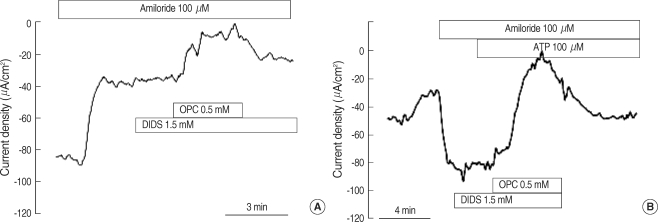1. Wynn R, Har-El G. Recurrence rates after endoscopic sinus surgery for massive sinus polyposis. Laryngoscope. 2004; 5. 114(5):811–813. PMID:
15126735.

2. Bernstein JM, Yankaskas JR. Increased ion transport in cultured nasal polyp epithelial cells. Arch Otolaryngol Head Neck Surg. 1994; 9. 120(9):993–996. PMID:
8074828.

3. Boeynaems JM, Communi D, Gonzalez NS, Robaye B. Overview of the P2 receptors. Semin Thromb Hemost. 2005; 4. 31(2):139–149. PMID:
15852217.

4. Lazarowski ER, Tarran R, Grubb BR, van Heusden CA, Okada S, Boucher RC. Nucleotide release provides a mechanism for airway surface liquid homeostasis. J Biol Chem. 2004; 8. 27. 279(35):36855–36864. PMID:
15210701.

5. Stoos BA, Garcia NH, Garvin JL. Nitric oxide inhibits sodium reabsorption in the isolated perfused cortical collecting duct. J Am Soc Nephrol. 1995; 7. 6(1):89–94. PMID:
7579075.

6. Compeau CG, Rotstein OD, Tohda H, Marunaka Y, Rafii B, Slutsky AS, et al. Endotoxin-stimulated alveolar macrophages impair lung epithelial Na+ transport by an L-Arg-dependent mechanism. Am J Physiol. 1994; 5. 266(5 Pt 1):C1330–C1341. PMID:
7515564.

7. Dong YJ, Chao AC, Kouyama K, Hsu YP, Bocian RC, Moss RB, et al. Activation of CFTR chloride current by nitric oxide in human T lymphocytes. EMBO J. 1995; 6. 15. 14(12):2700–2707. PMID:
7540975.

8. Ramis I, Lorente J, Roselló-Catafau J, Quesada P, Gelpí E, Bulbena O. Differential activity of nitric oxide synthase in human nasal mucosa and polyps. Eur Respir J. 1996; 2. 9(2):202–206. PMID:
8777951.

9. Kang BH, Huang NC, Wang HW. Possible involvement of nitric oxide and peroxynitrite in nasal polyposis. Am J Rhinol. 2004; Jul–Aug. 18(4):191–196. PMID:
15490564.

10. Jaffe LF, Nuccitelli R. An ultrasensitive vibrating probe for measuring steady extracellular currents. J Cell Biol. 1974; 11. 63(2 Pt 1):614–628. PMID:
4421919.

11. Nicholas RA, Watt WC, Lazarowski ER, Li Q, Harden K. Uridine nucleotide selectivity of three phospholipase C-activating P2 receptors: identification of a UDP-selective, a UTP-selective, and an ATP- and UTP-specific receptor. Mol Pharmacol. 1996; 8. 50(2):224–229. PMID:
8700127.
12. Al-Nakkash L, Hu S, Li M, Hwang TC. A common mechanism for cystic fibrosis transmembrane conductance regulator protein activation by genistein and benzimidazolone analogs. J Pharmacol Exp Ther. 2001; 2. 296(2):464–472. PMID:
11160632.
13. Boucher RC, Stutts MJ, Knowles MR, Cantley L, Gatzy JT. Na+ transport in cystic fibrosis respiratory epithelia. Abnormal basal rate and response to adenylate cyclase activation. J Clin Invest. 1986; 11. 78(5):1245–1252. PMID:
3771796.

14. Knowles MR, Stutts MJ, Spock A, Fischer N, Gatzy JT, Boucher RC. Abnormal ion permeation through cystic fibrosis respiratory epithelium. Science. 1983; 9. 09. 221(4615):1067–1070. PMID:
6308769.

15. Stutts MJ, Fitz JG, Paradiso AM, Boucher RC. Multiple modes of regulation of airway epithelial chloride secretion by extracellular ATP. Am J Physiol. 1994; 11. 267(5 Pt 1):C1442–C1451. PMID:
7526700.

16. McCarty NA, McDonough S, Cohen BN, Riordan JR, Davidson N, Lester HA. Voltage-dependent block of the cystic fibrosis transmembrane conductance regulator Cl-channel by two closely related arylaminobenzoates. J Gen Physiol. 1993; 7. 102(1):1–23. PMID:
8397274.
17. Nicholas RA, Lazarowski ER, Watt WC, Li Q, Boyer J, Harden TK. Pharmacological and second messenger signalling selectivities of cloned P2Y receptors. J Auton Pharmacol. 1996; 12. 16(6):319–323. PMID:
9131407.

18. Kennedy C, Qi AD, Herold CL, Harden TK, Nicholas RA. ATP, an agonist at the rat P2Y(4) receptor, is an antagonist at the human P2Y(4) receptor. Mol Pharmacol. 2000; 5. 57(5):926–931. PMID:
10779375.
19. Paradiso AM, Ribeiro CM, Boucher RC. Polarized signaling via purinoceptors in normal and cystic fibrosis airway epithelia. J Gen Physiol. 2001; 1. 117(1):53–67. PMID:
11134231.

20. Morse DM, Smullen JL, Davis CW. Differential effects of UTP, ATP, and adenosine on ciliary activity of human nasal epithelial cells. Am J Physiol Cell Physiol. 2001; 6. 280(6):C1485–C1497. PMID:
11350744.

21. Ralevic V, Burnstock G. Receptors for purines and pyrimidines. Pharmacol Rev. 1998; 9. 50(3):413–492. PMID:
9755289.
22. Khakh BS, Burnstock G, Kennedy C, King BF, North RA, Séguéla P, et al. International union of pharmacology. XXIV. Current status of the nomenclature and properties of P2X receptors and their subunits. Pharmacol Rev. 2001; 3. 53(1):107–118. PMID:
11171941.
23. Taylor AL, Schwiebert LM, Smith JJ, King C, Jones JR, Sorscher EJ, Schwiebert EM. Epithelial P2X purinergic receptor channel expression and function. J Clin Invest. 1999; 10. 104(7):875–884. PMID:
10510328.

24. Al-Nakkash L, Hu S, Li M, Hwang TC. A common mechanism for cystic fibrosis transmembrane conductance regulator protein activation by genistein and benzimidazolone analogs. J Pharmacol Exp Ther. 2001; 2. 296(2):464–472. PMID:
11160632.
25. Jang YJ, Lee CH. Localization of cystic fibrosis transmembrane conductance regulator in epithelial cells of nasal polyps and postoperative polypoid mucosae. Acta Otolaryngol. 2001; 1. 121(1):93–97. PMID:
11270501.
26. Hess A, Bloch W, Rocker J, Peters S, Stennert E, Addicks K, et al. Detection of nitric oxide synthases in physiological and pathophysiological processes of the nasal mucosa. HNO. 2000; 7. 48(7):489–495. PMID:
10955225.








 Citation
Citation Print
Print


 XML Download
XML Download